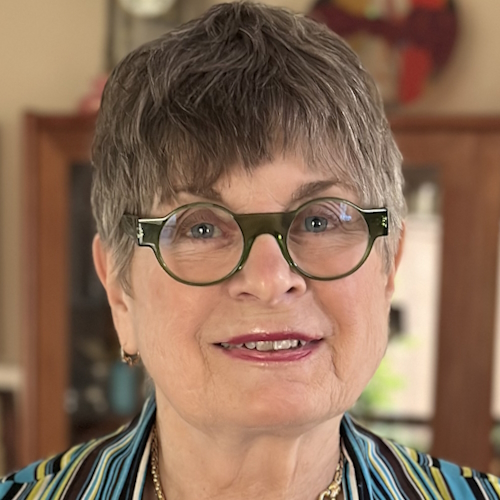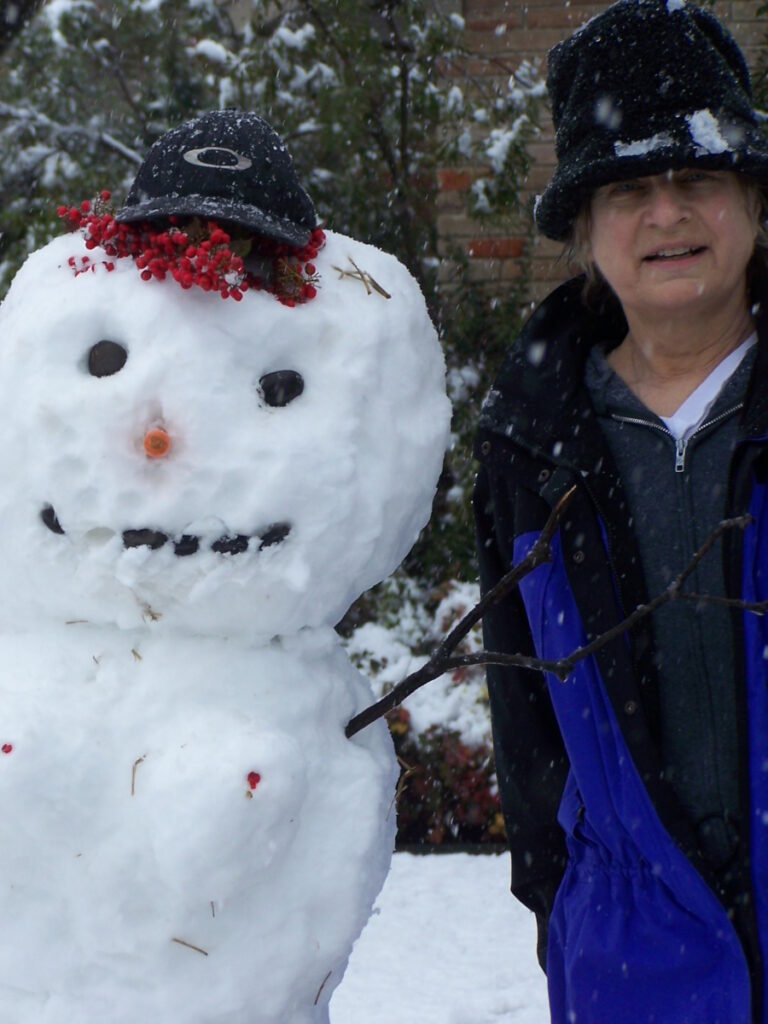Andrea’s Myelofibrosis Story
Interviewed by: Taylor Scheib
Edited by: Katrina Villareal

When Andrea was 50 years old, she heard the words no one ever imagines they’ll hear: “You have cancer.” It wouldn’t be the first time, either. Ten years later, Andrea learned her rare cancer, essential thrombocythemia, turned into a different one, myelofibrosis. Andrea made the difficult decision to have a stem cell transplant, which would later save her life.
Andrea and Denise share their journey through Andrea’s diagnosis of essential thrombocythemia, its progression to myelofibrosis, and the life-altering decision to undergo a stem cell transplant. Andrea offers insights into living with a rare blood disorder, participating in clinical trials, and embracing life post-transplant. Denise provides a heartfelt perspective as a care partner, highlighting the emotional and logistical challenges of supporting a loved one through treatment.
Together, their story underscores the importance of advocacy, resilience, and unwavering support in the face of adversity.
- Name: Andrea S.
- Age at Diagnosis:
- 50
- Diagnosis:
- Essential thrombocythemia (ET), later progressing to myelofibrosis (MF)
- Symptoms:
- Fatigue
- Anemia
- Treatments:
- Targeted therapy: JAK inhibitor
- Blood transfusions
- Allogeneic stem cell transplant


Thank you to Karyopharm Therapeutics for supporting our patient education program! The Patient Story retains full editorial control over all content.
This interview has been edited for clarity and length. This is not medical advice. Please consult with your healthcare provider to make treatment decisions.
- Introduction
- How My Essential Thrombocythemia Was Found
- My Essential Thrombocythemia Morphed Into Myelofibrosis
- Going to a Rare Blood Cancer Specialist
- Being in a Clinical Trial
- Bringing Up a New Clinical Trial to Her Doctor
- Starting to Discuss a Stem Cell Transplant
- Getting Ready for the Stem Cell Transplant
- Overcoming the Fear
- Life After the Stem Cell Transplant
- Talking with My Doctors
- More Hope for MPN Patients
- How I’ve Changed
I felt young, vibrant, and energetic, and I had no symptoms, so I thought I’d get over this and it would be fine.
Andrea
Introduction
Andrea: My passion has always been sports in some way. I played rugby in Chicago. I have been riding a bike for as long as I can remember, which was made very difficult by my disease. I had to make some modifications. When it comes to this disease, modifications are the way of life.


How My Essential Thrombocythemia Was Found
Andrea: I didn’t have any symptoms. I was feeling great. Luckily, I had insurance, so I would go for a health checkup once a year to make sure everything was well. My doctor said, “Your platelets are a little high. I’ve been looking at the trend and I don’t like what I’m seeing. Why don’t I send you to a hematologist-oncologist?”
My platelet count was not as high. Normally, they don’t treat until your platelet count is 100,000 or more. I was at about 600. When I went to the hematologist-oncologist, he said, “They say not to treat this low, but I’ve had some bad experiences, so I would like to treat you.” I agreed. I felt young, vibrant, and energetic, and I had no symptoms, so I thought I’d get over this and it would be fine. I had no issues for 10 years.
I started feeling fatigued, but I blamed it on everything else, like not sleeping enough or not eating right.
Andrea
My Essential Thrombocythemia Morphed Into Myelofibrosis
Andrea: It was very slow and insidious. I started feeling fatigued, but I blamed it on everything else, like not sleeping enough or not eating right. I have a group that rides on Sundays, and we bike about 55 miles around the DFW airport. I was so fatigued that I had a hard time keeping up with the group. I said to my partner, who was riding with me, “Man, they are picking up the pace.” She said, “No, Andrea, I think it’s you.”
I went to my local doctor and told him that I didn’t know what was going on. He saw that my hemoglobin was going down. We tried different things and they didn’t work. He said, “You have to have a bone marrow biopsy. I can do it, but I think you should go to a center of excellence, like MD Anderson.”


Going to a Rare Blood Cancer Specialist
Andrea: It was scary. You walk in, and there are all sorts of people. This is going to sound strange, but while walking through the halls, I thought, “Hey, look at me. I’m healthy. Look at these poor people.” I was thinking that I was so lucky. I’m not in a wheelchair, nor do I look like I’m going to keel over. I’m walking to my appointment, so things can’t be that bad.
Dr. Verstovsek gave me plenty of time, talked me through what I could have, and told me the tests I was going to be required to take so they could give me a proper diagnosis, and then we’d see what would happen from there.
I had a bone marrow biopsy, which can be very daunting and scary, but I have a high threshold of pain. I’m the type who doesn’t need anesthetic when I go to the dentist, so I thought the bone marrow biopsy wasn’t a big deal. It was a little difficult in the beginning because you’re very tense and scared, but it’s easy.
When I got my diagnosis, he told me that there were several different things we could do. We can watch it, but at that point, the only thing they could offer was a clinical trial.
The fatigue was difficult, and I was working to push through it. It’s interesting how your body adapts.
Andrea
Being in a Clinical Trial
Andrea: I wanted to get better. It was a selfish motive, and it was also a pay-it-forward motive. I thought this disease was so rare that even doctors didn’t know about it. If I can contribute to the overall landscape, I’m happy to, as long as it doesn’t kill me or make me worse.
I was on two trials. The first one didn’t work at all. The second one worked for a while, but then it was so toxic to my system that we had to stop. I was having connective tissue issues, and it was causing all sorts of problems.
I was on another trial that didn’t make much difference. It didn’t make me sick, but it didn’t cure the anemia, which was my main problem. The fatigue was difficult, and I was working to push through it. It’s interesting how your body adapts. I was still going out and riding my bike, which wasn’t at the level I was before, but I wasn’t going to let it stop me.


Bringing Up a New Clinical Trial to Her Doctor
Andrea: I stopped the drug. I got acute back pain and shingles. They put me on another drug, and that didn’t work either. I met with a local transplant doctor around 2011, but we determined that I wasn’t quite ready for a transplant at that point.
It worked for me for six years. I wasn’t great, but I was better than I was. I felt much more confident and alive. You have a 5- to 6-year window, until death ensues, to be perfectly honest about it, and so I made sure that I was seeing people and living life as well as I could.
After six years, my blood count started to drop. I became transfusion-dependent. I was having transfusions first every two months, then every month, and then every three weeks. That’s when Dr. Verstovsek said, “I think it’s time we looked at a transplant.”
If you’re looking at transplant centers, being close to home is not that important. What’s important is the experience of the center, the support staff of the center, and your comfort level.
Andrea
Starting to Discuss a Stem Cell Transplant
Andrea: I went to see the local transplant doctor. We talked, and then I thought, “Maybe I should get closer to home.” I went to two local hospitals that claimed to be transplant centers. They do general transplants, but when I talked to them, one center told me they were very focused on the number of successes. They weren’t sure that I would be a good candidate and that I could ruin their numbers. I couldn’t walk fast enough out of there.
I went to another hospital, and they were very good, but I thought I needed someone who specialized in my disease. I’m not having an organ transplant. This is completely different.
I also learned that what’s important is not only the transplant doctor but the support staff. They’re the ones who are with you all the time. If you’re looking at transplant centers, being close to home is not that important. What’s important is the experience of the center, the support staff of the center, and your comfort level.


Denise: We knew that there was no cure for myelofibrosis. Since there were no options, we had no choice. It was either do the transplant or don’t and continue suffering. Her quality of life was suffering from anemia.
When we made the decision, she did a lot of research. She had a lot of conversations with other transplant patients. What was it like? How was the transplant itself? What was the care like? What’s important? There wasn’t a lot of information out there at the time. Through that, that’s when we said we have to do it.
I was taking my life into my own hands, and that’s what the scariest part was because if it didn’t work, I had nobody to blame except myself.
Andrea
Getting Ready for the Stem Cell Transplant
Andrea: Once I decided on MD Anderson, I felt great. You have to go to the hospital about a month ahead of your transplant date to get chemotherapy. The night that I was supposed to have chemotherapy, I texted my local doctor and Dr. Verstovsek and asked, “Should I do this?” Up to the last second, I was so scared. He said, “There’s nothing left. This is what you need to do.”
While it wasn’t easy, it was the best thing I ever did. I had to change a lot of things, but here I am.


Overcoming the Fear
Andrea: I didn’t know if it would work. Fortunately, my sister was my donor, and she was a 10/10 match. Prior to the transplant, I had my will set up and got all my affairs in order because I didn’t know if I’d live or not.
The scary part about it was that I was making the decision. I wasn’t in an accident. I wasn’t forced to do this. I was taking my life into my own hands, and that’s what the scariest part was because if it didn’t work, I had nobody to blame except myself.
Luckily, I had support when I came home. I don’t know what I would have done without my sister and Denise.
Andrea
Life After the Stem Cell Transplant
Andrea: I spent four months in the hospital. Luckily, I had support when I came home. I don’t know what I would have done without my sister and Denise. Denise handled all the medication. There’s no way I could have done it.
Slowly but surely, I got better, day by day, week by week. It was very scary. Am I always going to be like this? Am I always going to have a lack of energy? Is it my age, that’s why I can’t remember this? Is it my disease? You’re scared to death that you’re going to not make it, but if you hold on, you see it gets better.
At around six months, I went back to work. I knew I wasn’t performing at the level that I thought I should be. They never said anything, but I said it was time to go.


Talking with My Doctors
Andrea: The doctors came in once a week with 5 or 10 people. I didn’t have a lot of communication with the nursing staff, but they were incredible. They were there when they were supposed to be there. They were always available. Denise and my sister were both there. Denise kept a spreadsheet of all the medications. The staff could not have been more knowledgeable.
I got mouth sores in my throat. The only thing I could taste was Oreo cookies. It was very hard to walk. They had all these incentives. MD Anderson and the nurses did so much to encourage people because the last thing you want to do is eat or walk.
When my blood count started to increase, they could see that the stem cells from my sister were beginning to work. They had a party and cheered. It was very positive. I never felt like the nurse told me something just to answer me. If they didn’t know, they didn’t know, and they would come back with the answer.
If you let the disease get to you, it will. But if you fight it with everything going on, it is not a death sentence.
Andrea
More Hope for MPN Patients
Andrea: The area of MPNs is growing exponentially. When I had the disease, there were no treatments available. Now, there are FDA-approved treatments. It’s come an enormously long way. Don’t give up hope. Keep a good attitude.
Do your research. Don’t be a victim of the disease. Look at the disease as it is and fight for it. Fight for your life, whatever you have to do. Talk to friends. Talk to doctors and get different opinions. Don’t immediately accept what somebody says. Make sure you feel comfortable with whatever that is.
Denise: From my perspective, it was a big deal. She’s here. It was the right decision, and I’m so grateful. We’re all going to die someday, but now, you get to enjoy life fuller and enjoy the little things. We did it.


How I’ve Changed
Andrea: My identity shifted. I was much more guarded and careful. I didn’t let my emotions show nor speak about how I was feeling necessarily. I felt embarrassed about it.
I don’t feel that way anymore. It changed my life. It’s not a death sentence. It’s very hard when you start reading and doing your research. It’s changing every day.
Don’t give up. Don’t sit and say you’re going to die. I can’t emphasize that enough. Your attitude is who you are and who you’re going to be. If you let the disease get to you, it will. But if you fight it with everything going on, it is not a death sentence. You will make it.

Special thanks again to Karyopharm Therapeutics for its support of our independent patient education content. The Patient Story retains full editorial control.

Inspired by Andrea's story?
Share your story, too!
More Myelofibrosis Stories
Stacy S., Myelofibrosis
Symptoms: Fatique, cold hands and feet
Treatments: Agrylin (for thrombocythemia), Ruxolitinib (Jakafi), Fedratinib (INREBIC), stem cell transplant
Mary L., Myelofibrosis
Symptoms: Fatigue, extreme dizziness (later diagnosed as vertigo)
Treatments: Pegasys, hydroxyurea (current)
Kristin D., Myelofibrosis
Symptoms: None; caught at routine blood work
Treatment: Stem cell transplant
Joseph C., Myelofibrosis
Symptoms: None; caught at routine blood work
Treatment: Clinical trial: VONJO (pacritinib)
Jeremy S., Myeloproliferative Neoplasm
Concurrent Diagnoses: Polycythemia vera (PV) & Chronic Lymphocytic Leukemia (CLL)
Holly S., Myelofibrosis
Symptoms: Severe fatigue, throbbing pain in left calf, significant weight loss, itching and rashes, bruising, and shortness of breath
Treatments: Chemotherapy, Immunotherapy
Cathy T., Myelofibrosis
Symptoms: None; caught at a routine blood test
Treatment: Stem cell transplant
Ben H., Myelofibrosis
Symptoms: None; caught at a routine blood test
Treatments: Hydroxyurea & aspirin, ruxolitinib
Andrea S., Myelofibrosis
Symptoms: Fatigue, anemia
Treatments: Targeted therapy (JAK inhibitor), blood transfusions, allogeneic stem cell transplant












